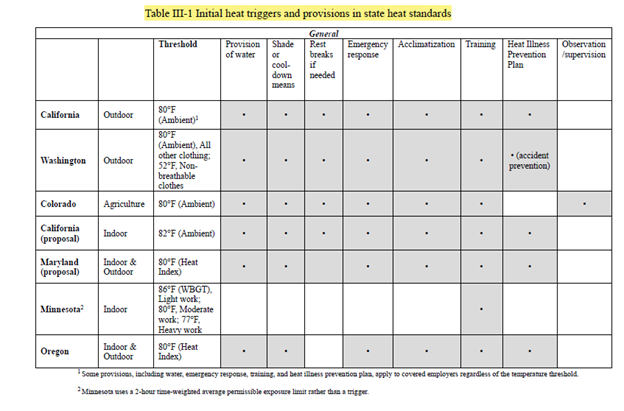As temperatures rise across the globe, the Occupational Safety and Health Administration (OSHA) has taken a significant step toward protecting workers from heat-related hazards. On July 2, 2024, OSHA released a proposed standard for Heat Injury and Illness Prevention in both outdoor and indoor work settings. This proposal, if finalized, will establish the first-ever federal standard requiring employers to implement comprehensive measures to assess and control heat hazards in their workplaces. Here’s what you need to know.
The Scope of the Proposed Standard
The proposed OSHA standard is broad, encompassing all employers who conduct work in outdoor and indoor settings across general industry, construction, maritime, and agricultural sectors. The rule is designed to protect employees from heat-related injuries and illnesses, a growing concern as climate change drives more frequent and intense heatwaves.
Currently, only five states—Colorado, California, Minnesota, Oregon, and Washington—have regulations in place to protect workers from heat hazards. Notably, Minnesota is the only state with standards that also cover indoor heat conditions. The proposed OSHA standard would expand these protections nationwide.
Key Components of the Proposed Standard
The proposed standard outlines several critical requirements that employers must implement:
- Heat Injury and Illness Prevention Plan (HIIPP): Employers must develop and enforce a worksite-specific plan to identify and control heat hazards.
- Heat Hazard Identification: Employers are required to assess both outdoor and indoor work environments for heat risks, with particular attention to conditions where the heat index reaches 80°F or higher.
- Control Measures at Initial Heat Trigger (80°F Heat Index): Employers must provide cool drinking water, access to shaded or air-conditioned break areas, acclimatization protocols for new or returning workers, paid rest breaks if necessary, and maintain effective communication with employees.
- High Heat Trigger Controls (90°F Heat Index): Additional measures include mandatory 15-minute rest breaks every two hours, monitoring employees for signs of heat-related illnesses, and posting warning signs in areas where ambient temperatures exceed 120°F.
- Heat Emergency Response: Employers must have a response plan for heat emergencies and take immediate action if an employee shows signs of heat-related illness.
- Training and Recordkeeping: Employers must provide initial and annual heat safety training for supervisors, safety coordinators, and employees. They must also keep records of indoor temperature monitoring data for at least six months.
All these requirements must be provided at no cost to employees, ensuring that financial barriers do not hinder compliance.
Impact on State Regulations
In states like Washington, which recently adopted permanent changes to their outdoor heat exposure rules, the proposed federal standard could lead to new indoor heat exposure regulations. Washington State’s Department of Labor & Industries (L&I) often adopts rules that exceed OSHA’s requirements, meaning employers must adhere to whichever set of rules offers more protection to workers.
For detailed information on outdoor heat exposure requirements, training resources, and answers to common questions, visit the Washington State Department of Labor & Industries’ “Be Heat Smart” page. This resource is essential for employers looking to ensure compliance and protect their workers from heat-related risks.
Looking Ahead
OSHA’s proposed standard is currently open for public comment, with a final rule expected by the end of 2024, barring any extensions. Employers should begin preparing now to ensure they can meet the new requirements once they are finalized. These proposed standards are summarized in the OSHA fact sheet.
The introduction of OSHA’s proposed heat standard marks a critical step forward in workplace safety. By preparing now, employers can ensure they are ready to comply with the new regulations, safeguarding their employees’ health and well-being in increasingly extreme temperatures. Stay informed and proactive to keep your workforce safe from the dangers of heat exposure.
Important Definitions
- Ambient temperature means the temperature of the air surrounding a body
- Heat index means the National Weather Service heat index, a measure indicating the level of discomfort the average person is thought to experience as a result of the combined effects of the ambient temperature and humidity of the air.





